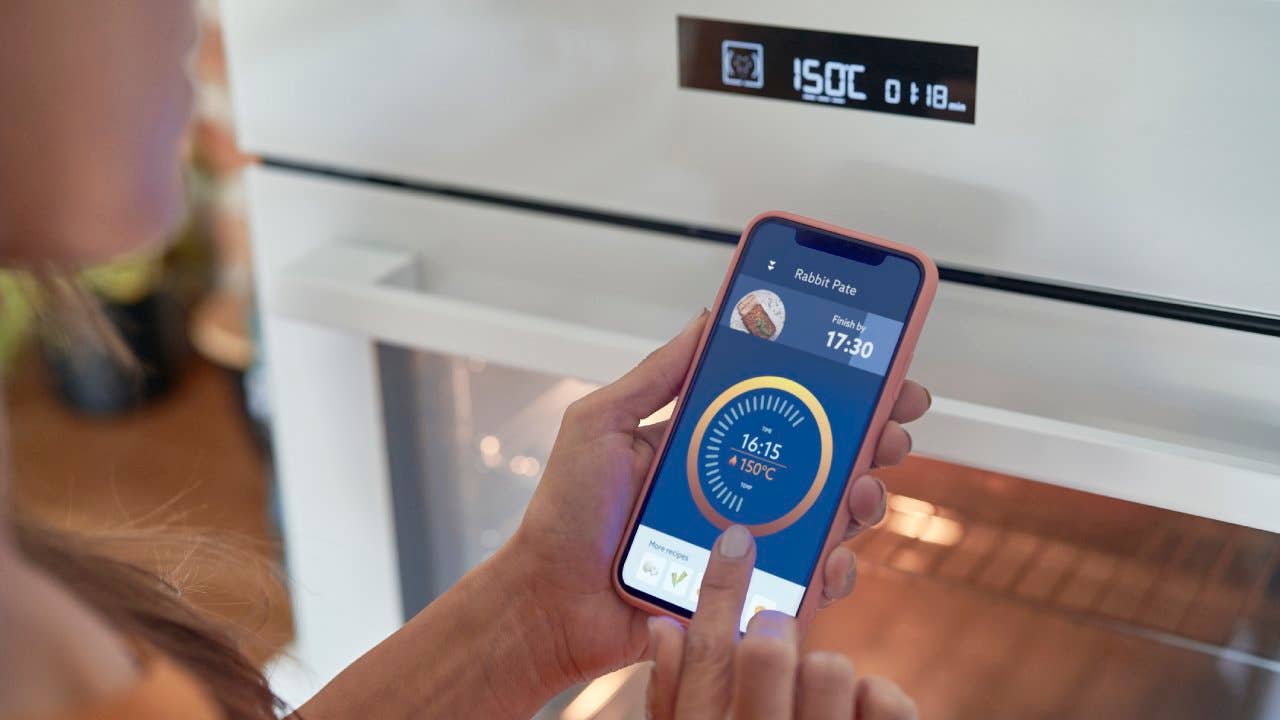How do smart ovens work?

Consumers love to splurge on new kitchen appliances, and when they do, more than a third upgrade to appliances with high-tech features — especially wireless controls, according to the “2022 U.S. Houzz Kitchen Trends Study.” Enter the smart oven, one of the latest internet of things (IoT) offerings.
Once only available as countertop appliances, smart ovens like the GE Profile series now come as full-size ranges and built-in wall models, too. Here’s how they work, what they can do and how to decide if they’re worth the investment in time and money.
How do smart ovens work?
Smart ovens don’t look that different from their regular full-size or countertop counterparts, and they run on electricity or gas. The big differences lie in how they’re controlled and the variety of cooking options they offer, along with other artificial intelligence features.
What makes the oven smart is its internet connection. Though it has conventional controls (knobs, dials and, increasingly, touchpad buttons), it also works through an app you download and install onto your phone or tablet, letting you program it from — well, anywhere. Plus, a smart oven can connect to a home Wi-Fi network or use Bluetooth, allowing you to manage it through smart hubs, such as the Amazon Echo.
What do smart ovens do?
The thinking module of a smart oven offers many interesting possibilities. Though options vary among brands, most smart ovens have certain capacities in common.
Remote programming
One of the biggest selling points of a smart oven is the ability to control the appliance from nearly anywhere at any time, via your smartphone or tablet. Once the oven’s connected, you can preheat it, set a timer, adjust the temperature or shut it off entirely — all without being in the kitchen (unlike the automatic start/stop programming of old, which had to be done in person). Some models even send a text notifications when your food is done.
Multiple cooking methods
The versatility of countertop and full-size smart ovens is unparalleled. Of course, they roast, bake and broil … but they also air fry, steam, convection heat and grill, to name just a few additional methods. Some, like the June 12-in-1 smart oven, offer such specialized procedures as stone-fire pizza baking, dough proofing and dehydrating.
In some cases, the oven automatically changes its functions and temperatures depending on what food it’s cooking (like finishing off a roasted steak with a fast-broiled char). Other ovens are compartmentalized, letting you bake various dishes at different temperatures within the same oven.
Expanded recipe options
Smart ovens (and their accompanying apps) often come with a library of recipes and cooking ideas. KitchenAid’s Smart Oven + even features a small touchscreen that can display video recipes and walk you through them. If you’re making something from its library, a smart oven can often automatically program itself to follow the cooking instructions.
Some smart ovens, like certain Tovala models, take recipes one step further by offering scan-to-cook functionality, meaning certain supermarket foods come with a scannable barcode that the smart oven can read to automatically set temperature and cooking times.
Voice and view controls
Some smart ovens, such as Whirlpool’s voice-activated models, let you speak to them: They have built-in integrated voice control that lets them respond to spoken commands. Others operate through external smart assistants, like Apple’s Siri, Amazon’s Alexa or Google Assistant.
One of the most unique features of the smart oven is built-in cameras for a live-stream experience. It’s a great way to keep an eye on your dishes and ensure they don’t burn or overcook without having to stay in the kitchen … or even the house. You can view what is happening from your phone or tablet and adjust the temperature or shut the oven off.
What are the advantages of smart ovens?
The main advantage of the smart oven is convenience. The appliance acts more like a thinking assistant than an oven when you know how to work with its features — a potential timesaver, when you know you can program a dish remotely or schedule cooking time in advance.
Despite the high price tags, smart ovens can also save you money over time. Although smart-oven technology may sound daunting, it can actually help foolproof oven use. You are less likely to burn a dish or cook it improperly, which means less food waste. Cameras, sensors, recipe programming and settings such as convection baking could reduce cooking times, potentially lowering your utility bill.
Plus, a multifunction oven can replace a lot of other little appliances, like air fryers, toaster ovens and slow cookers.
What are the drawbacks of smart ovens?
The biggest drawback to a smart oven is its cost. Smart ovens are often at least $1,000 more than their standard counterparts. Of course, you get what you pay for — more features and higher tech means the models are typically top-of-the-line versions with a higher price.
More features may also mean more parts failure and a higher repair bill down the road. When something goes wrong, service personnel may need to replace sensitive (and pricey) electronics such as motherboards or sensors.
In addition, smart ovens have a bigger learning curve than the traditional variety. Though connecting one to your home network should be fairly straightforward, tech isn’t always so simple. You may need to invest some phone time with a support agent to get it right. Plus, the many cooking features available can be overwhelming and may require some practice and experimentation to understand.
Should you buy a smart oven?
Smart ovens are ideal for home cooks willing to try new techniques and who are comfortable with tech in general. Otherwise, the added cost of a smart oven may not be worth it if you aren’t going to make use of its varied capacities — or only need an oven to heat up your take-out.
When shopping for a smart oven, read user reviews, speak with salespeople and look for a brand that offers good customer service and tech support — whether it’s a smart-appliance specialist, like June or Tovala, or a traditional manufacturer that’s getting into the smart game big time, like Breville or GE. And look for a good warranty. Though countertop smart ovens typically have a shorter, one-year warranty, full-size models may come with 10-year warranties or longer.
Think about the features that are most important to you and avoid being swayed by those you are unlikely to use. If you’d like to add some ease and variety to your cooking, however, you may find that a smart oven becomes the most beloved appliance in your kitchen, if not your entire home.
Why we ask for feedback Your feedback helps us improve our content and services. It takes less than a minute to complete.
Your responses are anonymous and will only be used for improving our website.
You may also like

How do self-driving cars work?





